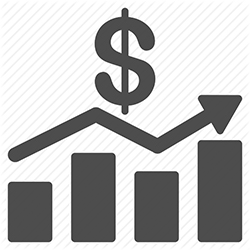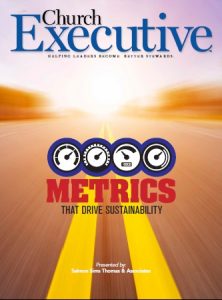By Rebecca M. DaVee, CPA
In 1856, 16 individuals formed First Presbyterian Church of Dallas. For 15 years, the congregation met in various locations, including the Dallas County Courthouse.
 Fast forward to 1872 — the Dallas Presbyterians had found a new church home, located on Elm and Ervay. With the arrival of the railroads, downtown Dallas grew, as did the Presbyterian Church. The congregation secured land and a loan for $2,500 for a new building located on the corner of Harwood and Main. In 1893, the building was enlarged and remodeled to accommodate a growing congregation. By 1909, church leadership elected to sell the property for $100,000 and relocate to the southwest corner of Wood and Harwood Streets. The land and construction cost of the new facility was $150,000. The building still stands today, and has retained its historical architectural design. It continues to be used by First Presbyterian for ministry and worship.
Fast forward to 1872 — the Dallas Presbyterians had found a new church home, located on Elm and Ervay. With the arrival of the railroads, downtown Dallas grew, as did the Presbyterian Church. The congregation secured land and a loan for $2,500 for a new building located on the corner of Harwood and Main. In 1893, the building was enlarged and remodeled to accommodate a growing congregation. By 1909, church leadership elected to sell the property for $100,000 and relocate to the southwest corner of Wood and Harwood Streets. The land and construction cost of the new facility was $150,000. The building still stands today, and has retained its historical architectural design. It continues to be used by First Presbyterian for ministry and worship.
 Healthy and sustained growth has certain criteria, represented by ministerial support, in the form of both people and funds. We can look to the pattern developed by First Presbyterian as an example of sustained growth. People gather to worship and serve a community. Over time, attendance and membership increase, providing additional funds for ministry and an expanding footprint. Funds for First Presbyterian were raised and leveraged, land was purchased, and buildings were constructed and eventually sold, with the proceeds going towards investing in a new facility. This is the funding cycle.
Healthy and sustained growth has certain criteria, represented by ministerial support, in the form of both people and funds. We can look to the pattern developed by First Presbyterian as an example of sustained growth. People gather to worship and serve a community. Over time, attendance and membership increase, providing additional funds for ministry and an expanding footprint. Funds for First Presbyterian were raised and leveraged, land was purchased, and buildings were constructed and eventually sold, with the proceeds going towards investing in a new facility. This is the funding cycle.
Leveraging a church’s short-term assets (cash / liquid investments) to expand long-term assets (property, plant, equipment or marketable / private investments) should provide facilities and investment earnings for ministry. Servicing debt (principal and interest) uses operating funds, and maintaining land and buildings requires maintenance; these assets depreciate over time. Buying publicly-traded stocks, bonds, mutual funds or other investments can provide earnings that are used for ministry activities.
The following three metrics help us evaluate the cost of financing debt; assets held for property, plant and equipment; and funds invested in public and private financial markets.
4 key debt-related key performance indicators (KPIs)

Our first set of debt-related KPIs helps churches measure the cost of debt to the annual operating budget (cash expenses), and to total equity. How much of your annual budget is consumed by interest and debt payments? What is the average interest rate for your debt, and what is your debt-to-equity ratio?
Formula:
1) Interest expense divided by total cash expenses = % of total costs paid to finance debt
2) Debt retirement (principal and interest) divided by cash expenses = % of budget dedicated to retiring debt
3) Interest expense divided by total debt = average rate of financing
4) Total debt divided by total net assets (i.e., equity) = % of resources dedicated to financing long-term assets
Our second set of KPIs focuses on the cost of maintaining your facility and equipment. These “fixed” assets represent resources invested in the physical “brick and mortar” of the church. Our metrics calculate the percentage of PP&E to total assets, utility cost per square foot, repair and maintenance cost per square foot and the prospective replacement reserves for PP&E.
Formula:
1) Total costs of fixed assets used in operations divided by total assets = resources invested in brick and mortar
2) Total utility costs (or total of any other occupancy cost) divided by total square feet of your buildings
3)Annual depreciation expense (amortized cost of the asset) may be used to set aside earnings (net assets) to replace PP&E. (This helps churches create a repair and replacement fund.)
![]() The previous KPIs measured the long-term assets that serve in ministry operations. Our last set of KPIs measures ministry resources that generate investment earnings for churches. When churches effectively use excess reserves to generate income, to support its mission then funds are “regenerating” earnings for the church. The formula below is an example on how to effectively monitor those funds:
The previous KPIs measured the long-term assets that serve in ministry operations. Our last set of KPIs measures ministry resources that generate investment earnings for churches. When churches effectively use excess reserves to generate income, to support its mission then funds are “regenerating” earnings for the church. The formula below is an example on how to effectively monitor those funds:
1) Total investments divided by total assets = % of assets invested in public/private markets
2) Investment earnings divided by total investments = % of return from public investment pools
The life cycle of a church indicates that as membership / attendance grows, larger or more facilities are needed for activities. Churches that can successfully save and create reserves for future plant expansion have a significant advantage in managing debt retirement.
The costs of maintaining your physical assets are also a significant component of your annual budget. The overarching question to leadership remains — how much of your accumulated earnings should or can be used to maintain long-term assets? The answer to this question changes over time and circumstances; however, long-term sustainability with long-term goals are key.
Rebecca M. DaVee, CPA, is a partner with Salmon Sims Thomas & Associates. She has been working with churches, ministries, televangelists and other tax-exempt organizations for more than 30 years, helping church leaders create metrics for sustainability.


